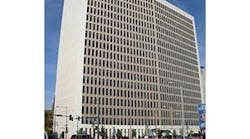Constructed in 1964, the Byron G. Rogers Federal Building and U.S. Courthouse in Denver is home to 11 government agencies. Its inefficient mechanical systems, however, were undermining GSA’s efforts to keep its carbon footprint in check.
Supported by $147 million in American Recovery and Reinvestment Act money, the agency has modernized the building to achieve an aggressive energy goal of less than 45.1 kBtu per square foot per year. Hitting this benchmark will reduce energy consumption by approximately 55% in the 620,000-square-foot structure.
Rather than raze the facility and start anew, GSA elected for an extensive retrofit. According to the National Trust for Historic Preservation, building reuse typically offers greater environmental savings over demolition and new construction projects. It can take 10-80 years for a new facility to overcome the climate change impacts created by its construction even with efficient operations.
This courthouse now uses high-performance systems while retaining its historic character. Key strategies included:
- Daylighting increased approximately 25% from the original design.
- Solar panels were installed on the roof to offset domestic hot water use.
- The building is primarily heated and cooled through the use of an active chilled beam system, which uses significantly less air than conventional HVAC options.
- The facility is equipped with 100% LED lighting.
By cutting energy demands in half, the courthouse will reduce its annual greenhouse gas emissions by more than 2,908 tons of CO2, which is the equivalent of taking 612 cars off the road or providing energy to 266 homes.


